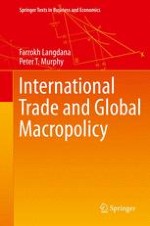2014 | OriginalPaper | Chapter
10. Exports and Imports, Real Exchange Rates
Authors : Farrokh Langdana, Peter T. Murphy
Published in: International Trade and Global Macropolicy
Publisher: Springer New York
Activate our intelligent search to find suitable subject content or patents.
Select sections of text to find matching patents with Artificial Intelligence. powered by
Select sections of text to find additional relevant content using AI-assisted search. powered by
